Antigua’s Disputed Slave Conspiracy of 1736
Does the evidence against these 44 slaves really stack up?
/https://tf-cmsv2-smithsonianmag-media.s3.amazonaws.com/filer/20130102113134Sugar-mill-plantation-yard-Antigua-web.jpg)
Breaking on the wheel was the most horrific punishment ever visited on a convicted criminal. It was a form of crucifixion, but with several cruel refinements; in its evolved form, a prisoner was strapped, spreadeagled, to a large cartwheel that was placed axle-first in the earth so that it formed a rotating platform a few feet above the ground. The wheel was then slowly rotated while an executioner methodically crushed the bones in the condemned man’s body, starting with his fingers and toes and working inexorably inward. An experienced headsman would take pride in ensuring that his victim remained conscious throughout the procedure, and when his work was done, the wheel would be hoisted upright and fixed in the soil, leaving the condemned to hang there until he died from shock and internal bleeding a few hours or a few days later.
“Breaking” was reserved for the most dangerous of criminals: traitors, mass killers and rebellious slaves whose plots threatened the lives of their masters and their masters’ families. Yet in the case of one man who endured the punishment, a slave known as Prince Klaas, doubts remain about the extent of the elaborate conspiracy he was convicted of organizing on the West Indian island of Antigua in 1736. The planters who uncovered the plot, and who executed Klaas and 87 of his fellow slaves for conceiving of it, believed it had as its object the massacre of all 3,800 whites on the island. Most historians have agreed with their verdict, but others think the panicky British rulers of the island exaggerated the dangers of a lesser plot—and a few doubt any conspiracy existed outside the minds of Antigua’s magistrates.
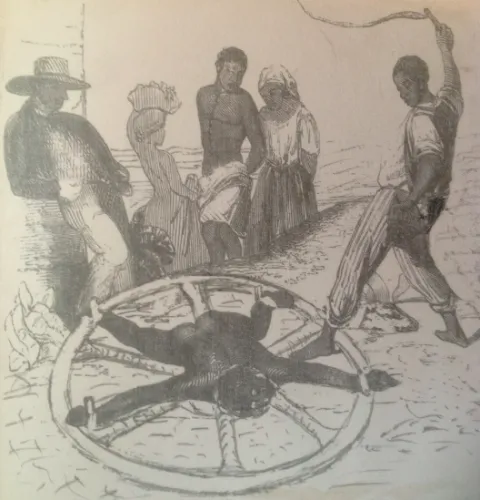
In order to understand why there were slaves on Antigua in the 18th century, and why they might have wanted to revolt, it is first necessary to understand the Caribbean sugar trade. Before Columbus stumbled on the Americas in 1492, few Europeans had ever tasted sugar. The limited supply came all the way from India, and its cost was so high that even a wealthy London merchant might consume, on average, one spoonful of the stuff a year.
Spain’s discovery of the islands of the Caribbean changed all that. Conditions there proved perfect for the cultivation of sugar cane, and by the early 17th century the Spaniards and the British, Danes and Dutch were all busily cultivating cane plantations from Trinidad to Puerto Rico. Sugar ceased to be a luxury commodity–but demand soared as prices fell, leaving the new white planter class that ruled the islands among the wealthiest merchants of their day.
Antigua itself might almost have been designed for the large-scale production of sugar. Although the island is only about 12 miles across, it has a stable climate, is blessed with several excellent harbors, and lies astride reliable trade winds–which drove the windmills that processed the cane.

The greatest difficulty that Antigua’s planters faced was finding men to farm their crops. Sugar cane is tough and fibrous, and requires considerable effort to cut; sugar was then extracted in the inhuman conditions of “boiling houses,” where vast fires were kept roaring day and night to heat the cane and refine its juices. At first the planters depended on indentured servants brought from home on long-term contracts, but the work proved too hard for all but the most desperate, and the islands acquired a reputation as hotbeds of disease. Most poor whites found it easier to seek work in the fast-growing colonies of North America. When they left, the planters turned to their only other source of manpower: slaves.
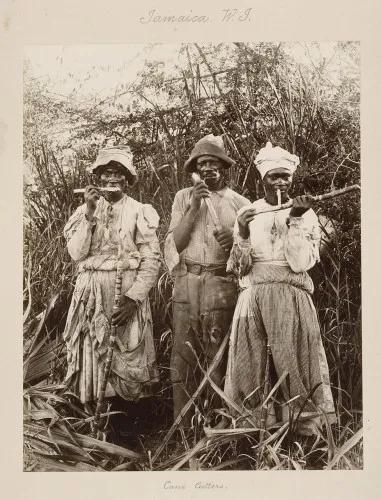
Between the 16th and 19th centuries, the slave trade produced the greatest forced migration known to history. An estimated 12 million Africans were shipped across the Atlantic, and even allowing for the two million who died en voyage, a vast number of slaves survived to reach destinations that ranged from Brazil to the colonies of North America. Four million of these men, women and children finished their journeys in the sugar islands of the Caribbean, where—thanks to the pestilential conditions—huge numbers were required to replace those who had died. It has been calculated that more than 150,000 slaves had to be landed in Barbados to produce a stable population of just 20,000: a phenomenon known to the planters as “seasoning.”
Seasoned slaves endured a monotonous diet—the staple diet of Antigua’s Africans was “loblolly,” a sort of porridge made from pounded maize—and worked six days a week. Given the heat, ceaseless labor and harsh discipline, it might be thought remarkable that the workers on the plantations did not rise more often than they did. Slaves soon made up the majority of Antiguan population—85 percent by 1736, when there were 24,400 of them on the island. But while sheer weight of numbers made rebellion possible, it also made the planters cautious. They formed militias, drilled regularly, and did what they could to prevent their slaves from congregating at dances and markets where talk might turn to revolt. Fear of rebellion also led to near-hysterical brutality. The least whisper of rebellion could prompt large-scale roundups, trials and executions, for it was clear that any large-scale revolt could only be fatal for the slaves’ masters.
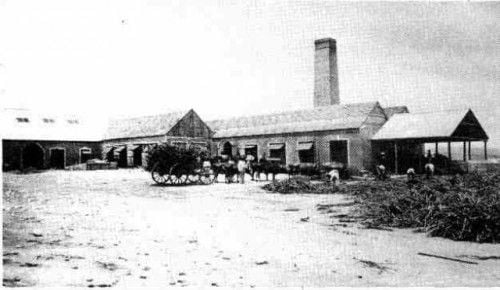
Slave resistance did occur on Antigua. In the 17th century, before the island was properly settled, runaways formed what were known as maroon societies—villages made up of escaped slaves who concealed themselves in the wild interior around the summit of Antigua’s extinct volcano, Boggy Peak. English justice was harsh; when the maroons were recaptured in a round-up ordered in 1687, one slave found guilty of “mutinous behaviour” was sentenced to be “burned to ashes,” and another, who had carried messages, had a leg sawed off. This treatment was not sufficient to dissuade others, though, and in 1701 fifteen recently arrived slaves rose against their owner, Major Samuel Martin, and hacked him to death for refusing to give them Christmas off. There was even a worryingly ritual aspect to the slaves’ revenge—they removed Martin’s head, doused it in rum, and, one contemporary reported, “Triumphed Over it.”
Next, in 1729, a plot came to light involving slaves belonging to the Antigua legislator Nathaniel Crump. Contemporary records say this conspiracy was betrayed by one of the slaves, and its intention (it was alleged in court) was to kill not only Crump and his family, but also the entire white population of the island. The judge hearing the case handed down what exemplary sentences—three of Crump’s slaves were burned alive, and a fourth was hanged, drawn and quartered. Reviewing the evidence, the court added a clear warning of more trouble ahead: “The design is laid much deeper than is yet imagined.”
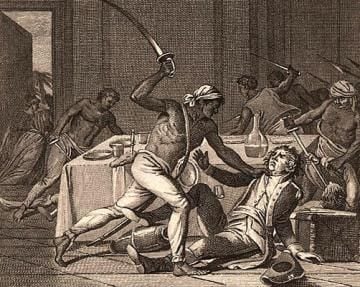
What followed over the next few years only increased the likelihood of further unrest. Antigua experienced a severe depression. There was also drought and, in 1735, an earthquake. Many planters responded by cutting costs, not least those involved in feeding and housing their slaves. The resultant unrest coincided with a successful slave rebellion in the Danish Virgin Islands, 200 miles to the northwest, which resulted in the massacre of the Danish garrison of St. John, the murder of many local planters (a number fled) and the establishment of slave rule in the territory for the better part of a year.
It was against this backdrop that the Antiguan slaves found a leader. The planters called him Court, a slave name that he apparently abhorred. His African name seems to have been Kwaku Takyi. Present-day Antiguans, however, know him as Prince Klaas and consider him a national hero. Having come to the island from West Africa in 1704, at age 10, Klaas became the property of a prominent plantation owner by the name of Thomas Kerby. He evidently possessed considerable presence; Kerby raised him to the rank of “head slave” and brought him to live in the Antiguan capital, St. John’s.
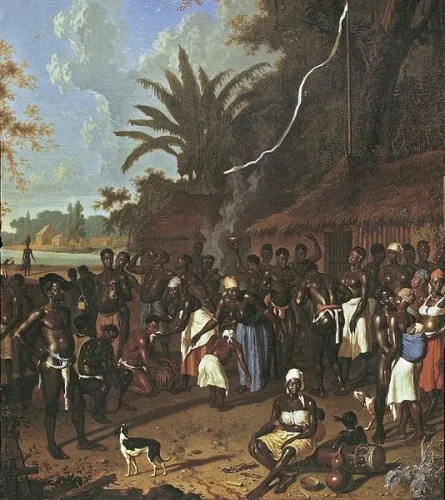
According to David Barry Gaspar, who has written in more detail on the subject than anybody else, Klaas was one of the masterminds behind an elaborate plot, hatched late in 1735, to overthrow white rule on Antigua. The conspiracy allegedly involved slaves on a number of large plantations, and was built around an audacious effort to destroy the island’s planters in a single spectacular explosion. Taking advantage of a large ball due to be held in St. John’s in October 1736, the slaves planned to smuggle a 10-gallon barrel of gunpowder into the building and blow it up. The detonation was to be the signal for slaves on the surrounding plantations to rise, murder their masters and march on the capital from four directions. A general massacre would follow, and Prince Klaas himself would be enthroned as leader of a new black kingdom on the island.
The planters on Antigua had no difficulty believing the details of this conspiracy–which, as they themselves would have been well aware, bore a striking resemblance to the infamous Gunpowder Plot of 1605. Court records dating to the time state that the conspiracy was discovered only by chance, after the ball was postponed by nearly three weeks and several slaves who knew of the plan could not resist hinting that things were about to change. Their “insolence” increased “to a very Dangerous Pitch,” Justice of the Peace Roberth Arbuthnot observed; a British constable reported that when he had tried to break up a crowd of slaves, one had shouted to him: “Damn you, boy, it’s your turn now, but it will be mine by and by, and soon too!”
Arbuthnot was sufficiently alarmed to make inquiries, which soon turned into a full-blown criminal investigation. One slave gave sufficient details for him to begin making arrests, and under interrogation (and occasionally torture), a total of 32 slaves confessed to having some stake in the scheme. In all, 132 were convicted of participating in it. Of this number, five, including Klaas, were broken on the wheel. six were gibbeted (hung in irons until they died of hunger and thirst) and 77 others were burned at the stake.
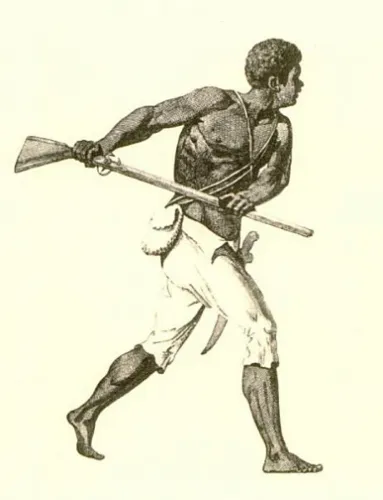
In the eyes of the Antiguan government, Prince Klaas’s planned rebellion was well evidenced. A stream of witnesses testified that the plot existed; Klaas himself, together with his chief lieutenant—a creole (that is, a slave born on the island) known as Tomboy, whose job it would have been to plant the powder—eventually confessed to it. Events on the Danish island of St. John showed that slaves were capable of executing conspiracies, and there were other parallels as well. In Barbados, in 1675 and in 1692, the authorities uncovered plots to massacre the white community that had apparently been kept secret for as long as three years. In each of these cases, the leaders of the planned rebellions were said to have been “Coromantees“—slaves from what is now Ghana, the same part of West Africa from which Prince Klaas had come.
Klaas is a figure of compelling interest to historians. Gaspar and others argue that his influence over his fellow slaves went further than the Antiguan planters of the day realized, since, according to the official report on the planned uprising, “it was fully proved that he had for many Years covertly assumed among his Countrymen, the Title of King, and had been by them address’d, and treated as such.” They further identify him as an Ashanti, a member of a tribal confederation renowned for discipline and courage, not to mention abundant use of human sacrifice.
The most intriguing evidence relating to Prince Klaas concerns a public ceremony held a week before the planned rebellion. In the course of this ritual, Gaspar says, Klaas was enthroned by an “obey man”—an obeah-man, that is; a priest, shaman or sorcerer who practiced the West African folk religion known as voodoo or santería. In other Caribbean risings, it was the obeah-man who administered oaths of loyalty to would-be rebels with a mixture made of gunpowder, grave dirt and cock’s blood; strong belief in his supernatural powers helped cement loyalty. Michael Craton is not alone in arguing that the ceremony Antigua’s obeah-man presided over was actually a war dance,
“set up by Tackey and Tomboy ‘in Mrs Dunbar Parkes’ Pasture, near the Town,’ viewed by many unsuspecting whites and creole slaves… as simply a picturesque entertainment. But for many slaves it held a binding significance, for it was an authentic Ikem dance performed by an Ashanti king in front of his captains once he had decided on war.
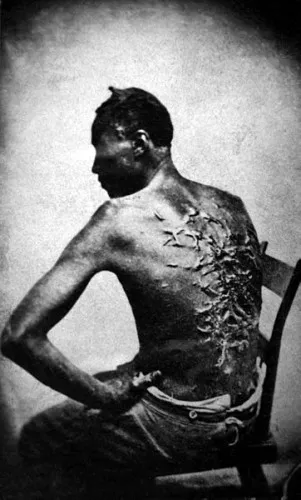
Other evidence that Prince Klaas was really planning an uprising comes from Arbuthnot’s inquiry, which concluded that there had been warning signs of rebellion. Slaves had been seen congregating after midnight and heard blowing conch shells to announce their meetings. Yet —confessions aside—little physical evidence of a conspiracy was ever produced. The “10-gallon barrel of powder” that Tomboy was to have used to blow up the ball was not recovered; nor, despite extensive searches, were any weapons caches found.
All this has led researchers such as Jason Sharples and Kwasi Konadu to direct renewed attention to the slaves’ own testimonies. And here, it must be acknowledged, there is good reason to doubt that the confessions obtained by Arbuthnot were wholly reliable. Konadu persuasively argues that Klaas’s “dance” was probably a familiar Ashanti ceremony acclaiming a newly chosen leader, and not a declaration of war. Sharples demonstrates that Arbuthnot’s prisoners would have found it easy to exchange information and discuss what the captors wished to hear, and adds that they must have known that a confession—and the betrayal of as many of their fellow Africans as possible—was their one hope of saving themselves. He also supplies an especially revealing detail: that one slave, known as “Langford’s Billy,” who “escaped with his life by furnishing evidence against at least fourteen suspects” and was merely banished in consequence, turned up in New York four years later, heavily implicated in another suspected slave plot that many researchers now concede was merely a product of hysteria. Thrown into prison, Billy confided to a fellow inmate that he “understood these affairs very well” as a result of his experiences on Antigua, and that “unless he…did confess and bring in two or three, he would either be hanged or burnt.” He even offered, Sharples says, likely names “as proper ones to be accused.”
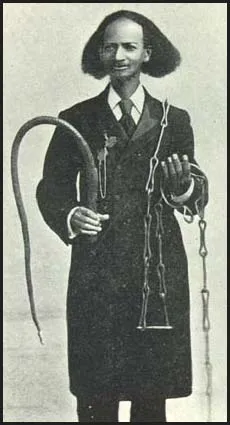
The verdict thus remains in balance. Large-scale slave rebellions did take place in the Caribbean, and plantation slaves were capable of forming elaborate plans and keeping them secret. Yet, as Jerome Handler argues in the case of the supposed Barbados plots, there is also evidence that frightened British overstated the threats they faced; perhaps Prince Klaas planned something serious, but short of the extermination of all the planters of Antigua.
Finally, it is also worth remembering a point well-made by Michael Johnson, who a decade ago published an influential article arguing that another renowned African “conspiracy”—the uprising supposedly planned by Denmark Vesey in Charleston in 1822–was probably the product of white panic, duress and leading questions. Johnson showed that the very hideousness of slavery predisposes historians to search for evidence of slave conspiracies; after all, who would not have tried to rebel against such injustice and cruelty? To find no evidence of black resistance might lead some to conclude that the slaves lacked courage, rather than—as is the fairer verdict—that they had little hope, and were viciously repressed.
Whatever the truth of the Antiguan rebellion, change was slow to come to the island. Measures were put in place to prevent the free association of slaves, but there was also a slow Christianization of the black population, with most of the work was done by the Moravians, who numbered nearly 6,000 converts by 1785. By 1798, local laws allowed “unrestrained” worship on Sundays.
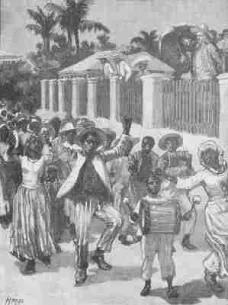
Uniquely among the isles of the West Indies, Antigua emancipated all its slaves at the first opportunity; the entire plantation workforce of 32,000 souls was freed at midnight on August 1, 1834 the earliest date mandated by Britain’s act of emancipation. “Some timorous planter families,” noted James Thome and Horace Kimball, two abolitionists who made a six month “emancipation tour” of the West Indies at the behest of the American Anti-Slavery Society, “did not go to bed on emancipation night, fearing lest the same bell which sounded freedom of the slaves might bring the death knell of their masters.” But others greeted their former slave the next morning, “shook hands with them, and exchanged the most hearty wishes.”
The slaves faced an uncertain future–competing now with whites and with one another for work, and no longer guaranteed any sort of care in their old age. But no trouble of any sort occurred. “There was no frolicking,” Thome and Kimball reported; rather “nearly all the people went to church to ‘tank God to make a we free! There was more “religious” on dat day dan you can tink of!’ ” And the Antiguan writer Desmond Nicholson puts it this way: “When the clock began to strike midnight, the people of Antigua were slaves…when it ceased, they were all freemen! There had never been in the history of the world so great and instantaneous a change in the condition of so large a body of people. Freedom was like passing suddenly out of a dungeon into the light of the sun.”
Sources
Michael Craton. Testing the Chains: Resistance to Slavery in the British West Indies. Ithaca : Cornell University Press, 2009; David Eltis and David Richardson. Atlas of the Transatlantic Slave Trade. New Haven: Yale University Press, 2010; David Barry Gaspar. “The Antigua slave conspiracy of 1736: a case study in the origins of resistance.” The William and Mary Quarterly 35:2 (1978); David Barry Gaspar. “‘A mockery of freedom’: the status of freedmen in Antigua society before 1760.” In Nieuwe West-Indische Gids 56 (1982); David Barry Gaspar. Bondmen and Rebels: A Study of Master-Slave Relations in Antigua. Durham : Duke University Press, 1993; Jerome Handler. “Slave revolts and conspiracies in seventeenth century Barbados.” In Nieuwe West-Indische Gids 56 (1982); Michael Johnson. “Denmark Vesey and his co-conspirators.” In The William and Mary Quarterly, 58:4 (2001); Herbert S. Klein and Ben Vinson III. African Slavery in Latin America and the Caribbean. New York: Oxford University Press, 2007; Kwasi Konadu. The Akan Diaspora in the Americas. New York: Oxford University Press, 2010; Russell Menard. “Plantation empire: how sugar and tobacco planters built their industries and raised an empire.” In Agricultural History 81:3 (2007); Desmond Nicholson. Africans to Antiguans: The Slavery Experience. A Historical Index. St John’s, Antigua: Museum of Antigua and Barbuda; Jason Sharples. “Hearing whispers, casting shadows: Jailhouse conversation and the production of knowledge during the Antigua slave conspiracy investigation of 1736.” In Michele Lise Tarter and Richard Bell (ads). Buried Lives: Incarcerated in Early America. Athens: University of Georgia Press, 2012.
/https://tf-cmsv2-smithsonianmag-media.s3.amazonaws.com/accounts/headshot/mike-dash-240.jpg)
/https://tf-cmsv2-smithsonianmag-media.s3.amazonaws.com/accounts/headshot/mike-dash-240.jpg)